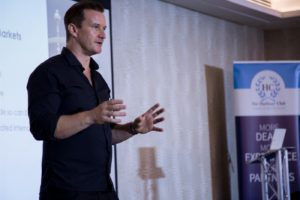Imagine that wealth building is like rocket science. It’s the speed you need to achieve in order to break out of the Earth’s gravitational pull. You might be wondering: how fast do you need to go to make the income you want?
To answer that, first imagine that your salary is a trap that keeps you locked in your current wealth pattern.
Your expenses accumulate to fill the amount of your salary, whatever amount that is. You keep making your salary to meet your financial obligations—your car payments, your rent/mortgage, or whatever else you’re paying on a monthly basis.
This wealth pattern creates a trap that keeps you where you are. Wealth building is like your attempt to break out of that gravitational pull. When you escape velocity investing, you’re creating additional income streams to replace that income so your income can then be fully invested.
Here’s the current problem. Most gurus and books about wealth all tend to focus on scrimping your lifestyle. They tell you not to buy Starbucks everyday and take that $3 and invest it. When you compound the interest on that $3, then by the time you’re 164 years old (if you manage to live that long), you’ll have enough to retire.
Creating Capital Events
But I don’t believe you can save your way—or scrimp your way—to wealth. That’s not how you achieve escape velocity investing, which is what you really want. What you really want is first to create capital events that you can profit from.
Now, what is a capital event? It’s selling a company and its assets to make a profit. But first, you
have to get chunks of cash, and those chunks of cash have to be deployed into genuine passive income-generating investments.
That means that your income has to exceed what you spend on a monthly basis. When you have more money than you spend each month, you’ve reached escape velocity.
That also means you can then effectively invest 100 percent of what you earn. So, for example, if you earn consulting fees or you have a job, that money can be 100 percent invested month to month. Your wealth will snowball and grow.
It’s the initial chunk that’s a bit tricky to get to, but once you’ve broken free and achieved that, your wealth growth becomes exponential. It’s like how people often say the first million is the hardest to get to but going to 10 million is easier. That’s absolutely true.
You reach this kind of escape velocity with the income that you can generate from deploying that capital you have in an efficient manner. To achieve the capital events I mentioned earlier, there are two main ways. One of them is real estate and the other is through businesses.
With real estate, the simplest way is development. You buy crappy properties, you fix them up, and you sell them. Lots of people are really well at doing that. They sometimes do that with their primary residence, which is quite tax efficient. But one of the drawbacks of real estate, obviously, is it requires quite a bit of cash investment. You have to put money down to buy the property, then you have to invest in the actual refurbishment.
The other way, of course, is my favorite, which is buying businesses. You can buy a business using no money down and you can sell it for six or seven figures later on. Quite often the business doesn’t need a full refurbishment.
You don’t need lots of money invested to do that. You just need to know how to financially re-engineer the balance sheet, and how to turn a breakeven business into a highly profitable business. Or you can turn a profitable business into an even more profitable business.
It’s more about learning the kind of tricks and tactics to improve the value of a business before you sell it later on. Basically, by buying and then selling a business and creating a capital event, you can deploy that capital and create the income that takes you toward escape velocity.
Investing to Create a Capital Event
The next question then is what you would invest in to achieve that escape velocity.
Most people look at the things that banks and financial advisors recommend to them, such as mutual funds. These funds are perhaps spitting off two or three percent a year in income. Advisors might suggest a deposit account that has one percent or less interest being generated. I want to look beyond these options.

When you’re wealthy enough to have private wealth banking, you’ll see that most of the big investment funds from Schroeder’s and UBS, for example, or the people who have these kinds of managed mutual funds actually have two categories of funds.
The first is a retail category which has reasonably high fees. There is also another version of the retail category which is sold by IFA which has a really high fee structure so they can also pay the IFA commissions out of it.
Then they have an institutional grade for institutions, such as family offices, for people to buy. It has an incredibly low fee structure, which means you get a lot more impact from the investment and you get a lot more of the money rolled up in a compounding effect.
You might have heard Warren Buffet and people like him saying, “Don’t buy mutual funds because the fee structure is such a headwind on compounding your money.” You’re better off using a very low strategy and very low fee structure products such as ETFs. Actually, the institutional version of many of these managed funds has a similar fee structure to an ETF. So, it’s a much less expensive way to deploy your capital.
Your goal should be to get onto the private wealth banking ladder because that’s when you get access to these institutional grade funds. But you also get access to things like fixed coupon notes and other products that enable you to capture very high returns on your capital deployed.
What you’ll find is that your escape velocity number is much smaller. For example, to generate $100,000 of annual income, you probably only need $400,000-$500,000 deployed through private wealth banking to comfortably achieve that without taking massive amounts of risk.
Doing that in a retail environment is almost impossible. In fact, you simply cannot do it. Now, there are some options and strategies that you can use if you understand that area. You’ll have a lower risk and generate those sorts of income that I talked about.

But that’s definitely something you would need to educate yourself on. It’s quite an active strategy, which you have to look at on a fairly regular basis to understand how to place those options and trades. But the first thing you need to do is calculate what the cost is.
Everything measured improves. If you have a goal and you’re measuring your progress, it’s going to help you a lot on the way to getting there. So, figure out what your base cost is. What’s your cost of living? What do you need to have invested to achieve that?
And finally, what kind of deal do you need to do to get that level of cash deployed to get your escape velocity so that you can get that financial freedom that much quicker?
If you want to learn how to buy businesses without using cash up front and then be able to sell them to create these capital events, download my free special report. I also invite you to consider joining the Harbour Club and attending one of our virtual events where you’ll not only learn more about how to do all that I’ve discussed, but also meet and work with other members who have successfully applied these strategies and techniques. I look forward to having you as part of my community.
Let’s Connect!



